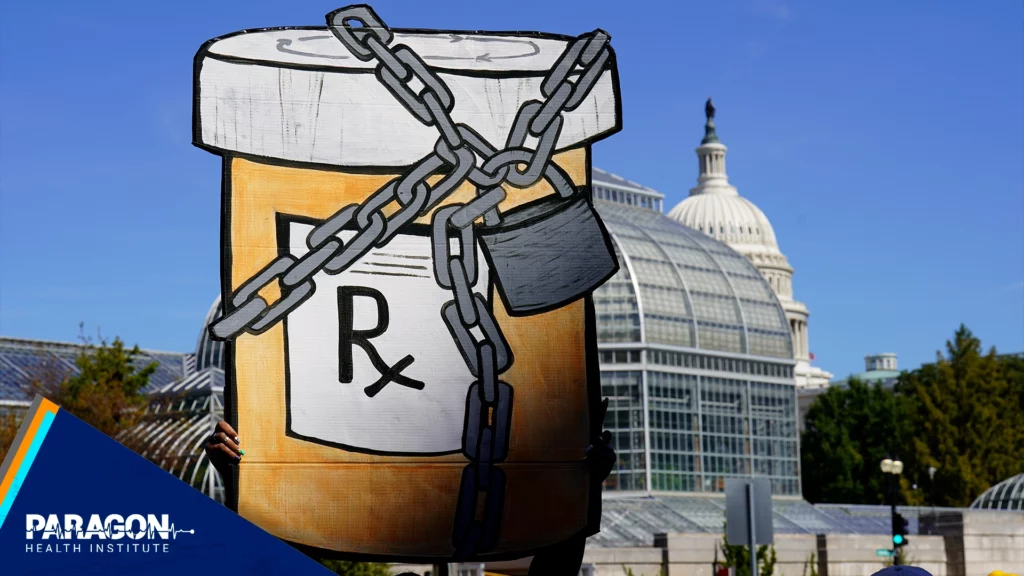On August 29, President Biden announced the first 10 drugs that will be subject to price negotiation in the Medicare Part D program under the terms of the Inflation Reduction Act (IRA), a statute Biden now admits has little to do with reducing inflation.1 Yet, there is little cause for celebration. The purported benefits of the statute will not materialize for several years, if at all. The negotiated and potentially lower drug prices will not be applied until 2026. Meanwhile, at least eight lawsuits have been filed in federal courts across the nation by the U.S., Michigan, and Ohio Chambers of Commerce; the drug industry’s trade group, PhRMA; and multiple drug manufacturers, which contend that the negotiation program is unconstitutional and inconsistent with other statutes.2 One or more of these lawsuits could result in the program being delayed or struck down entirely.
But there are more fundamental problems. The IRA’s program of negotiation and price controls is likely unnecessary. And, if the program proceeds, its costs in terms of forgone innovation and decreased health will outweigh any benefits.
Key Takeaways
- Average net prices for drugs—the price paid after all rebates and discounts—was stable or falling before the IRA was enacted. Overall prescription drug inflation has been much lower than general inflation, and the median annual out-of-pocket spending per user on retail drugs has been falling.
- The drug negotiation provisions in the IRA are not negotiations in any normal sense of the word. They empower the federal government to dictate arbitrary prices and subvert normal market mechanisms.
- The IRA’s drug price controls will likely impose greater costs in terms of forgone innovation and decreased health than any economic or health benefits.
A Solution in Search of a Problem
The IRA’s drug provisions were premised on the misconception that prescription drug prices are out of control. In fact, the Congressional Budget Office (CBO) reports that after decades of increases, per capita spending on prescription drugs began to level off in real terms in the mid-2000s and has fallen as a percentage of total spending on health care services and supplies since then.3 Critics focus on high list prices, particularly for specialty drugs and new biologic agents. But the average net price of a prescription—the amount actually paid after subtracting discounts and rebates that manufacturers provide—”fell from $57 in 2009 to $50 in 2018 in the Medicare Part D program.”
The decline in net prices reflects the increased use of lower-cost generic drugs, which now account for nine out of 10 prescriptions. U.S. patients use more generics and pay less for them (an average of 16 percent less) than patients in other developed countries.4 Generic approvals accelerated during the Trump years so much so that overall drug prices (CPI-Rx) actually declined in 2018. Prescription drug inflation has been zero over the past few months (April to July 2023) and was just 2.8 percent over the past year (July 2022 to July 2023), well below the general inflation level.5 U.S. drug spending as a percentage of health expenditures is lower than the average percentage of 11 developed countries.6
Data from the Medical Expenditure Panel Survey show that drugs’ affordability is improving, not deteriorating. Between 2009 to 2018, median annual out-of-pocket spending per user on retail drugs fell by nearly half, from $93 to $54. For the highest spenders at the 95th percentile of the distribution, out-of-pocket spending fell from $1,369 to $945. In Medicare Part D, median per capita out-of-pocket spending fell by more than half, from $341 to $160. The Part D 95th percentile fell by a third, from $2,265 to $1,490.7
An Unnecessary, Counterproductive Program to Dictate Prices
Medicare, the federal health program for adults 65 and older and disabled people, covers prescription drugs purchased at retail pharmacies under Part D and drugs administered by health care providers in outpatient settings under Part B.
Prior to the IRA, Medicare drug prices were competitively negotiated in the market. In Part D, prices were determined through negotiations between manufacturers and insurers or their pharmacy benefit managers. Direct negotiation between Medicare and manufacturers was forbidden by law. In Part B, prices were determined by a statutory formula that paid providers who administer the medication the drug’s average sales price (ASP)—that is, the average price paid, including most negotiated rebates and discounts by all nonfederal purchasers in the United States—plus 6 percent.
Medicare Part D, in particular, was set up as a market-oriented program in which private-plan insurers (which also provide commercial insurance) compete for enrollees based on benefits and price, such as premiums and cost sharing, and negotiate drug discounts to keep costs down. There is no compelling reason to change it. Roughly 50 million Medicare beneficiaries (three quarters of the Medicare population) have voluntarily enrolled,8 costs, with the exception of a temporary spike in 2014-2015 for new specialty Hepatitis C drugs, have consistently been below projections, the average enrollee has a choice of 57 different plans,9 and more than 80 percent of enrollees are satisfied with the program.10
Negotiation in Name Only
The IRA upends this system. It directs the Secretary of Health and Human Services to “negotiate” the “maximum fair price” (MFP) of some high-expenditure, single-source Medicare drugs. But this is Godfather-style negotiation.
The Secretary will select from among the 50 drugs with the highest expenditures in Medicare Part D and the 50 drugs with the highest expenditures in Part B. Ten Part D drugs have been selected in 2023 for negotiation with prices to take effect in 2026, and 15 additional Part D drugs will be selected in 2025 with prices taking effect two years later. In 2026, Part B drugs will be added to the mix: A total of 15 additional Part D or Part B drugs will be selected and in 2027, and thereafter, 20 additional Part D or Part B drugs will be selected annually, with prices kicking in two years after selection. By 2029 there will be 100 drugs selected for negotiation, with potentially more to come.
Selected drugs must have been on the market for at least seven years for small molecule drugs and 11 years for biologics. They cannot be selected if they face competition from one or more approved generic equivalents or biosimilars. Because the negotiated prices are generally not imposed for two years after selection, selected small molecule drugs and biologics will be subject to negotiated drug prices nine and 13 years (respectively) after Food and Drug Administration approval and marketing. This is substantially shorter than the average 14.4 years of market exclusivity that small molecules have recently enjoyed prior to generic competition and the even longer period for biologics.11
However, the selection process does not indicate that the selected drugs are currently overpriced. On the contrary, it could impose artificially low prices on the most valuable treatments, depressing supply and harming patients. Expenditures can be high because prices are high or because large quantities are used—normally the sign of an effective therapy. Drugs could be selected for negotiation precisely because they are valuable and treat large numbers of patients, regardless of whether they have unreasonably high prices.
A good example is one of the newly selected drugs, Eliquis, an anticoagulant that is widely used to prevent strokes in patients with atrial fibrillation (a heart rhythm disorder), and to treat venous thromboembolic disease (blood clots in leg veins that can disperse into the lungs).12 Both conditions are relatively common in the Medicare-age population. Eliquis was the most costly to the Medicare program of the ten drugs selected, costing $16.5 billion between June 2022 and May 2023, primarily because it was used by 3.7 million Medicare enrollees. Eliquis is far more expensive than the much older, standard blood thinner Warfarin. But it is more effective in preventing strokes and requires much less monitoring to ensure effectiveness and to reduce the risk of associated hemorrhage, making Eliquis more cost effective than Warfarin.13
The third-costliest drug selected, Xarelto, is also an oral anticoagulant that works in the same way as Eliquis.14 It cost Medicare about $6 billion per year but was used by more than 1.3 million patients, meaning it had roughly the same per-patient-per-year cost as Eliquis. Like Eliquis, Xarelto is more expensive than Warfarin but generally more cost effective.15
Both Eliquis and Xarelto were odd selections, as it is believed that generic versions of both could be on the market by 2026 and 2024 (respectively)—before the fair price is slated to go into effect.
The IRA makes the Secretary the sole arbiter of which drugs will be negotiation-eligible. It provides no administrative or judicial route to dispute this selection.
Once drugs are selected, the Secretary will have virtually unlimited power to set prices. A manufacturer has until October 1 to sign an agreement stating it will negotiate with the Secretary. The following day it will have to submit a long list of proprietary information plus “any information that CMS requires to carry out negotiation” to the agency that administers Medicare, the Centers for Medicare and Medicaid Services (CMS).16 CMS is free to obtain and consider other information, including the drug’s effectiveness, therapeutic alternatives, and net prices.
CMS must provide manufacturers with an initial offer for the MFP within four months (February 1, 2024). How it will develop this offer remains mysterious. As CMS notes, “While the statute requires CMS to provide an initial offer and a justification, it does not specify how CMS should determine an initial offer nor how or to what degree each factor should be considered.”17
The manufacturer will have to either accept the initial offer or make a counteroffer along with a justification for that counteroffer within 30 days. CMS has 30 days to accept or reject the counteroffer. If CMS rejects the counteroffer, there will be up to three meetings with the manufacturer over the next four months. CMS plans on sending each manufacturer of the 10 selected drugs a “Notification of Final Maximum Fair Price Offer” by July 15, 2024.
The IRA provides only vague guidance on how the final MFP will be determined. It sets upper limits, but CMS can set the prices lower, something CBO expects will occur.18 It requires CMS to consider certain manufacturer-specific factors and information but does not specify how CMS should weigh these different elements in determining the maximum fair price.19
The whole process is a sham. CMS has all the leverage and absolute discretion on setting the price. There is no requirement that CMS do anything more than meet with a manufacturer. And there is no administrative and judicial review available to appeal price determinations.
The manufacturer must take it or leave it. If a company refuses to negotiate or does not agree to the Final Maximum Fair Price that CMS sets, it must either withdraw all its drug products from the Medicare and Medicaid programs—an option that will be financially infeasible—or be subjected to a confiscatory excise tax of up to 95 percent of all sales of the drug. In other words, manufacturers are given a Hobson’s choice: Either “choose” to negotiate and sell to Medicare at the “fair price” it selects or give up your right to profitably sell drugs.
Artificial Limits on Price Increases
The IRA drug provisions also limit price increases of all Medicare drugs to the inflation rate. Manufacturers will pay CMS a rebate if their prices—the average manufacturer price (AMP) for Part D drugs or the ASP for Part B drugs—increase faster than the general consumer price index. Yet the AMP—the amount wholesalers that distribute drugs to pharmacies pay to manufacturers—does not reflect the net prices of drugs, which include substantial post-sale rebates and discounts that manufacturers pay to health plan drug buyers.20
The IRA thus ties rebate penalties to increases in the list price rather than increases in the net price. List prices are much higher and increase faster than net prices—potentially due to recent growth in average discounts/rebates as a share of the list price.21 This makes it likely that manufacturers will be subjected to inflation rebate penalties even though their collected net profits will increase slower than the list price increases.
The inflation provision also disrupts normal market mechanisms that reflect the value added of a drug. Normally, if a drug is valuable, demand for it will rise and higher prices will elicit greater supply. But if the price is artificially limited to below a market clearing price, there will be shortages of the most effective medications.
Moreover, according to CBO, these inflation price limits will elicit higher launch prices for new drugs, because manufacturers will no longer be confident of their ability to subsequently raise prices to match future market conditions.22 The result will be higher out-of-pocket payments—normally based on list prices—for insured patients and higher prices for patients who lack drug coverage and must pay list prices. Some patients will forgo valuable new treatments because of increased costs.
This unintended, but predictable, initial price inflation will affect the newest and most innovative drugs that are most likely to improve health. Higher launch prices risk putting life-saving treatments out of reach for vulnerable low-income and minority populations, which are disproportionately uninsured or unable to afford higher coinsurance payments.23
Regardless of whether drug prices are too high, it is indisputable that the IRA’s price controls will lessen the number of innovative, lifesaving new drugs that ultimately become the low-priced generics most Americans use. Numerous academic studies have demonstrated a significant negative relationship between drug price controls and investment in pharmaceutical research and development (R&D) and access to new drugs.24 For every 10 percent decrease in prices, there was a 5 percent to 6 percent decrease in R&D investment, leading to decreased future drug discovery. And countries with drug price controls suffer fewer drug launches and more launch delays, leading to decreased access to new drugs compared to the United States.25
The Council of Economic Advisers estimated that an earlier version of the IRA’s price controls—H.R. 3, the Lower Drug Costs Now Act of 2019—would keep 100 new, lifesaving drugs from Americans over the following decade and reduce Americans’ average life expectancy by an estimated four months.26 University of Chicago economist Tomas Philipson estimated that the IRA’s various provisions would decrease revenues, leading to an 18.5 percent ($663 billion) decrease in R&D spending, resulting in 135 fewer new drugs and 331.5 million fewer life years by 2039.27
Another estimate predicts that pharmaceutical revenues would decrease by 10 percent to 15 percent.28 If R&D expenditures parallel revenues, that would translate into 130-195 fewer drugs of the approximately 1,300 new drugs expected over the next 30 years.
CBO estimates that the negative effect on pharmaceutical development will be less, projecting just 7 fewer new drug approvals through 2042 and a total of 15 fewer drugs over 30 years resulting from the IRA.29 This prediction is difficult to evaluate, as it is basically a black box with few details on how it was calculated. CBO does not specify how much pharmaceutical revenues will be impacted, so it is difficult to estimate how much R&D will be impacted. And CBO acknowledges that its estimates “are subject to uncertainty.”
Fifty percent of products in the development pipeline are cancer drugs. President Biden—who has repeatedly touted his “cancer moonshot”—should have considered how many lifesaving cancer drugs will be lost before he signed the IRA.
The decrease in new drugs will not just harm health through the loss of innovative new therapies. It may also increase the costs of existing drugs in the same therapeutic category. A new study has confirmed what economic theory has long predicted: The introduction of new brand name drugs increased competition with existing drugs in the same therapeutic class. This therapeutic competition reduced annual net price growth by 4.2 percent. Net commercial spending was 18.5 percent lower than it would have been absent therapeutic competition.30
The IRA may also reduce discovery of new uses for existing drugs. Existing drugs can often be repurposed for different diseases.31 For instance, non-oncology drugs are being investigated to combat cancers, and oncology drugs are investigated and used against other types of cancers or for non-oncology indications.32 Drugs that have been in clinical use for many years have accumulated a significant body of pharmacological data, including pharmacokinetics, toxicity, and safety. This significantly reduces development times and costs as compared to new drugs.
These efforts can expand the economic return and health benefits of current, marketed drugs by determining new indications and/or formulations. Recent examples include Keytruda (Pembrolizumab), a drug that was originally approved to treat melanoma that now treats many other kinds of cancer as well, and Rituxin (Rituximab), which was originally approved for one type of lymphoma but is now widely used for other types of blood cancers and autoimmune disorders such as rheumatoid arthritis and the skin disease pemphigus.
The IRA price negotiation process reduces the net present value of investments in new indications by shortening the time in which firms can earn returns on those investments and reducing prices. There will be less incentive to invest in research into new indications as lower, negotiated prices are imposed nine years (small molecules drugs) or 13 years (biologics) after drug approval, even if new beneficial uses are identified.
Generic manufacturers may also have decreased incentives to enter the market if the negotiated price of the branded counterpart is so low that it becomes more difficult to undercut it. Generic prices progressively decline as more generic manufacturers enter the market. But if the first generic manufacturer is dissuaded from coming in to compete, the progressive decrease in prices will be short circuited. This could undermine the shift to generics that has been so important in keeping U.S. drug prices relatively stable.
Conclusion
The 10 newly announced drugs selected for price negotiation, along with the other drug market provisions of the IRA, will destroy the market-based Part D system and substitute a bureaucratically directed price setting system that will stifle lifesaving and life-enhancing innovation. Congress should do vigorous oversight of the implementation of the IRA and work to mitigate the harms from the new drug price control regime.





